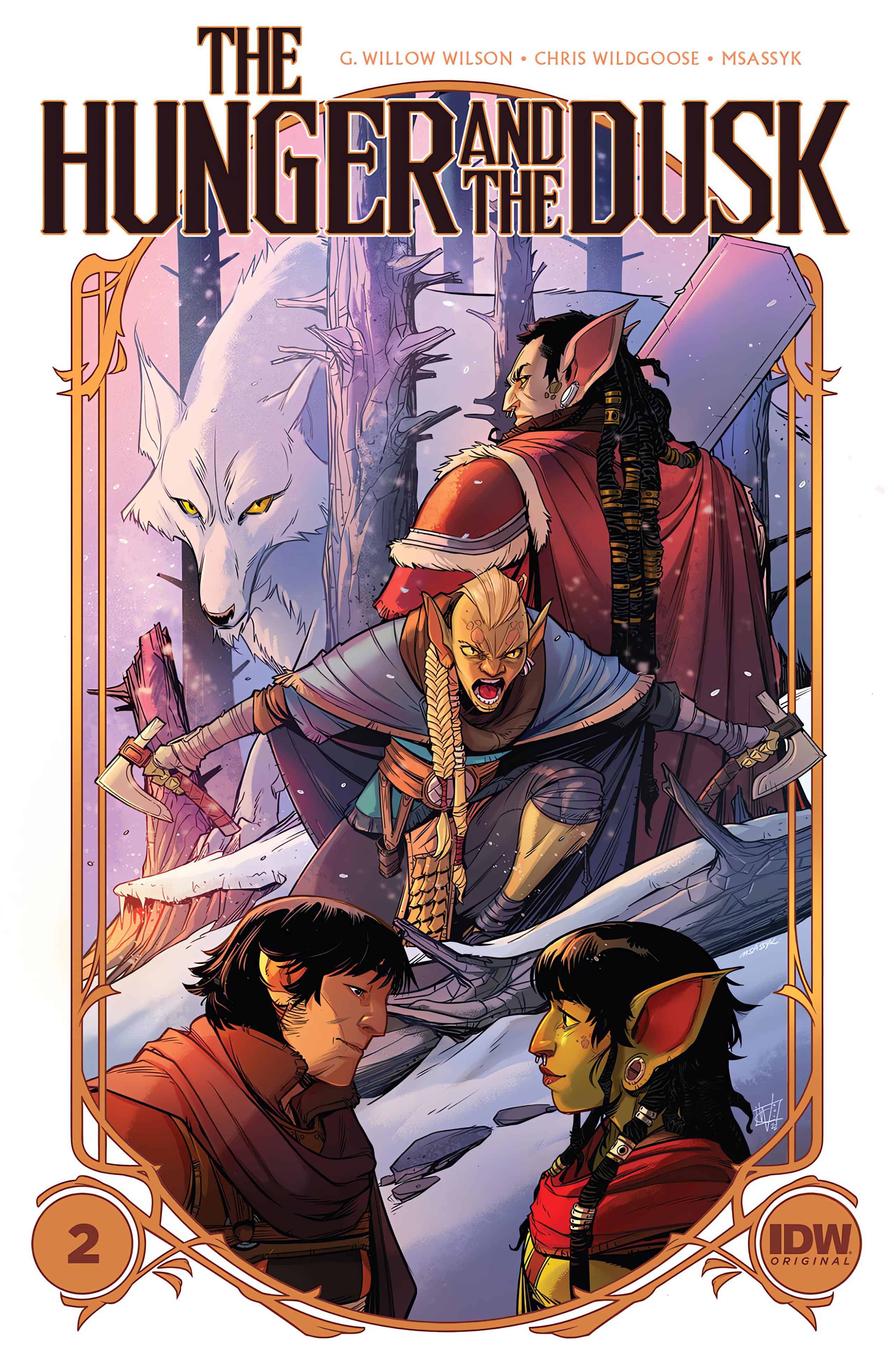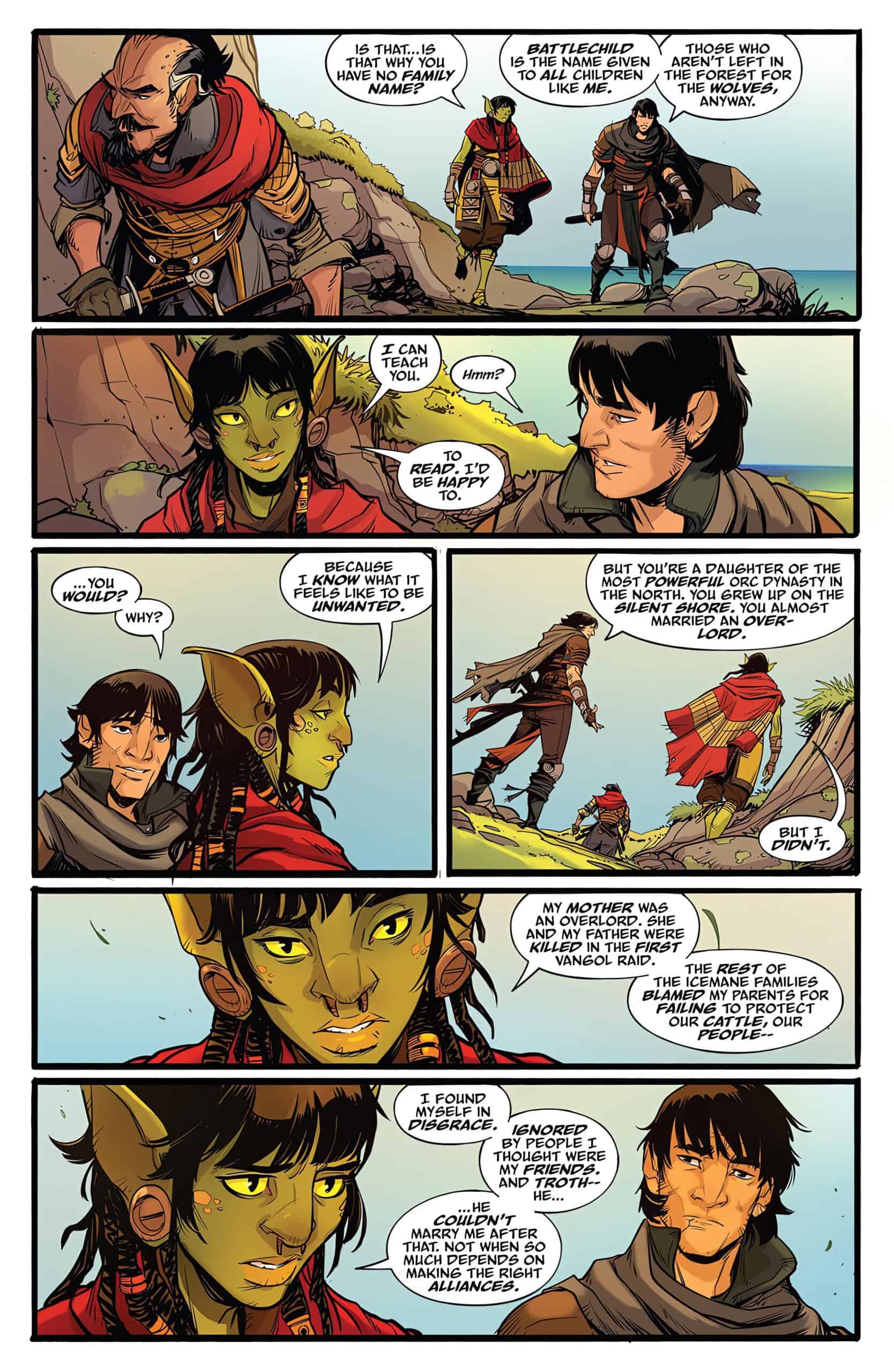The Hunger and the Dusk #2

Recap
Delicate alliances between humankind and orckind have been forged in a desperate effort to save both civilizations... but can they last? Reluctant orc ambassador Tara Icemane struggles with culture shock as she learns the ropes from her rugged human hosts, a company of fighters known as the Last Men Standing. But she'll have to set heartbreak aside and find common ground with Commander Callum Battlechild when the troop faces its first major battle against the invading Vangol. Meanwhile, the carefully arranged engagement between Troth Icemane and Faran Stoneback-the cornerstone of a plan to unite the two most powerful orc dynasties-will crumble if the couple fails to survive their first hours alone together on a death-defying matrimonial wolf hunt.
Review
A worry with stories that feature any kind of action is the creator’s use of combat to blind from deficits in emotion and storytelling. A lazy, or less confident creator, uses action as a crutch to bridge moments of exposition or emotion, set-dressing the story without digging any deeper. Great creators understand action works like song and dance in musicals, in that it is the ultimate expression of theme and emotion. When the feeling gets to be too much in a musical’s dialogue, characters back out into song. In action stories, when the emotion builds too much pressure, violence is the result.
The Hunger and the Dusk #2 – written by G. Willow Wilson with art by Chris Wildgoose, colors from Msassyk with assistance by Diana Sousa, and lettering by Simon Bowland – wastes no time in continuing the adventures of human and orc as they form an uneasy alliance to battle the Vangol. The book is split between Troth and Faran’s wedding hunt that will unite the various orc tribes, while on the other side of the lands, Callum and Tara bond over their disgraced lots in life.
The wedding hunt is a wild success as a tense fight helps to form a budding relationship between Troth and Faran that expands past political alliances. The duo defeats a pair of wolves that tie in into orc folklore, and signal a new day for the tribes of Icemane and Stoneback. Meanwhile, Tara works to learn the names of The Last Men, the mercenary company under Callum’s command, and she explains her recording of their exploits for the Silent Shore. The group pivots to planning an ambush on a Vangol ship but is detected before they can flank the monstrous beings.

The writing for this issue is filled with deep character moments, lingering on the small moments in reaction to the last issue’s bombastic action. The dueling plotlines echo the other in structure, starting in quiet beats before shifting into brutal combat. Wilson’s dialogue shines in these moments, crackling with a palpable blend of anguish and wistful desire. The budding romances are telegraphed from a mile away, and that lack of subtlety is refreshing as it gives a genuine flavor to the story.
Wilson makes the plot for the romance beats more compelling than the action in places (which is dynamite on every page) thanks to that embracing of tone and style. The script accepts the premise of good action, in that when the emotion gets too strong in the dialogue sequences, the story must move into an action beat. Both plotlines follow the trend, and the fight sequences are treated as the explosive result of the connections sparking. Wilson makes clear that the sword only comes out when the smoldering look between characters gets to be too much.
That focus on character and the progression into action is reinforced by Wildgoose’s art, which sells both paths with equal fervor. The panel layout for the issue is the key to understanding the equitable emphasis that the artist puts into both modes of the issue. Dynamic layouts are used not only in the action scenes, which employ sharp, diagonal panels with no gutters, while the dialogue scenes are more cinematic with wide shapes separated by thick borders and white spaces.

Where the two plotlines diverge is in the use of single page splashes towards the middle and end of the issue. In the wedding hunt section, Wildgoose illustrates Troth leaping into action to attack the massive wolf while the Callum story tackles a reaction beat, as Tara cradles one of the Last Men. The first is a kinetic lurch into battle, and Wildgoose employs a low angle that sells the orc’s acrobatic ability and heightens the danger of the wolf. The second splash is drawn at a typical angle, and instead of dynamic action, it’s a reaction beat that centers the bloody carnage as a result of the battle.
These two pages are the perfect embodiment of the story that the creative team is trying to tell, weaving high fantasy and pulpy romance into a tale of found connection and the triumph of the collective. Wildgoose’s art is the perfect marriage of action and emotion, and his ability to render layouts that match the specific tone of each beat is just jaw-dropping. Add this to a rich sense of worldbuilding and establishment of unique monster design work, and it just becomes staggering how much this series just works on paper.


Wildgoose’s art would be a wild success on its own, but the colors deployed by Msassyk add another enthralling dimension to the book. The use of icy blues and stark whites in the wedding hunt sequence invokes a chill in the reader, the freezing atmosphere sinking to the bone. Across the continent, the warm greens of the plain’s grass and soft oranges of the setting sun illustrate a beauty to the world that disarms right before a brutal slaughter. It feels wrong at times for this distinct, but picturesque, palette to be tainted by the overflowing violence of man (orc) vs. beast (Vorgal). It’s an excellent motif that reinforces the theme of community and relationship building, and dramatically raises the stakes of the Vorgal invasion.
Final Thoughts
The Hunger and the Dusk #2 works as a paradigm of the alchemy that is comics, fusing text and image to create a compelling narrative. Wilson’s script is bustling with the energy generated by the elevation of emotion into action, playing up the romance and lingering tensions. When paired with Wildgoose’s cinematic layouts and expressive linework, that progression is propelled into spellbinding territory. Adding Msassyk’s palettes on top works to reinforce the core themes of the work, and create distinct visual flavors for the two central plotlines. The Hunger and the Dusk does everything right, and with only two issues under its belts, has proven to be an instant classic.
The Hunger and the Dusk #2: Fire and Ice
- Writing - 10/1010/10
- Storyline - 10/1010/10
- Art - 10/1010/10
- Color - 10/1010/10
- Cover Art - 10/1010/10





